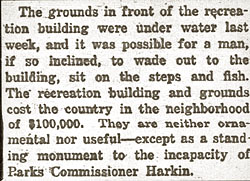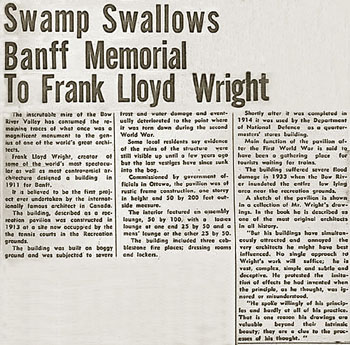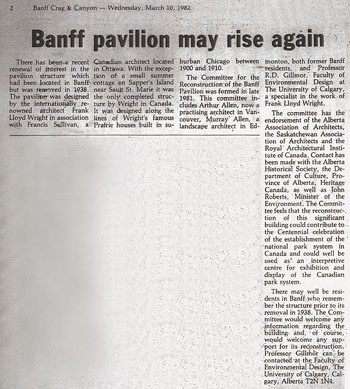|
Excitement, Resentment, Disaster, Genius, Resurrection:
Banff Crag & Canyon |
|
|
Excitement, Resentment,
Disaster, Genius, Resurrection. Within the archives of
the Whyte Museum of the Canadian Rockies in Banff, Alberta,
are a collection of news clippings from the Banff Crag &
Canyon, which offer a glimpse into the attitude of the local
residence toward the decisions of the Canadian Government
and the Banff Pavilion.
Although Alberta did
not join the Canadian Federation until 1904, a key to
Banff's growth was British Columbia and the Canadian Pacific
Railroad. In July of 1871, British Columbia became the fifth
Province to join the Canadian Federation with the promise
that the Canadian government would construct a national
railway, joining it with the Eastern Provinces. The railway
finally passes through the Banff area in 1883. That same
year hot springs are discovered in Banff on Sulfur Mountain
and railroad workers staked a claim. A year later in 1884,
Lord Steven, a former Canadian Pacific Railroad director,
christened the area "Banff" after his birthplace, Banffshire
in Scotland. In 1885 the Canadian government set aside a
reserve in the Banff area. Two years later it established
the Rocky Mountain Park, Canada's first National Park (it
was not until 1930 that it was renamed the Banff National
Park). To encouraged tourism in the area, the Canadian
Pacific Railway built the Banff Hot Springs Hotel in 1888,
promoted as an international resort and spa. As the area
grew as a tourist destination, so did the town of Banff.
Support also came from the Canadian Government, and in 1911,
Ottawa commissioned a "Park Shelter" in Banff.
Looking back, in 1911
Banff was approximately 2500 miles by rail from the Capital
of Canada. The nation was expanding westward. The
Banff/Calgary Coach Road opened, allowing automobile access.
The nation was expanding. Pushing westward. Their desire was
to support tourism. A pavilion that would represent all the
Canadian Nation was. A note of interest was the cost.
$20,000. Just seven years earlier, a building of comparable
size and design, the River Forest Tennis Club (1906) was
built at a cost of only $3,000. Rustic beams, art glass
windows, massive fireplaces. Wright exceeded their
expectations.
"Recreation
Building. The sealed tenders for the new recreation building
to be erected on the south side of the river have been sent
to Ottawa, where the decision awarding the contract will be
made. Superintendent Clarke hopes to have the building
enclosed before cold weather sets in... Work on the
recreation grounds has been progressing..." October 11,
1913.
Excitement builds.
Bids have been awarded. Jobs are opening up. One week later
it is reported that: "Work is Started - On the New
$20,000 Recreation Building. Preliminary work was started...
The structure will be of rustic frame, one storey in height, |
|
with cement and rubble
foundation. The outside dimension will be 50x200 feet... The
contract has been awarded to Bennett, Debman & Co., of
Calgary, and calls for the completion of the building by the
first of May..." October 18, 1913.
Enthusiasm wanes as
resentment sets in. "It is true a recreation building
is now under construction... but the building is only
suitable for a very few summer sports, picnicers’ lounging
place and drinking of afternoon tea, during four months of
the year... The original plans, as outlined by men who would
use the building as outlined by men who would use the
building and presumably know something of what was required,
called for a building containing accommodations for curling,
hockey and all kinds of winter sports, and would have cost
very little if any more than the one now under construction.
These plans were sanctioned by the people of Banff at a mass
meeting held in the National Park theater, but their wishes
and desires were, as usual, ignored by the 'over lords' at
Ottawa, who imagine they are wiser as to conditions in Banff
than those who live and have their being here." December
6, 1913. Ottawa held the purse strings.
"Banff Improvements.
Sup’t Clarke went down to Calgary on Monday night and all
the city papers, Tuesday, contained articles on
‘Improvements Projected at Banff’... Just what use the
government will make of the pavilion erected at the
recreation grounds last winter... neglected to inform the
press of Calgary... Crag and Canyon has contended that the
present building was utterly useless and the money used in
construction wasted..." June 13, 1914.
Disaster.
"The grounds in front of the recreation building were under
water last week, and it was possible for a man, if so
inclined, to wade out to the building, sit on the steps and
fish... They are neither ornamental nor useful except as a
standing monument to the incapacity of Parks Commissioner
Harkin." July 10, 1920.
Genius. One
never appreciates what one has until it is gone... "Swamp
Swallows Banff Memorial to Frank Lloyd Wright. The
inscrutable mire of the Bow River Valley has consumed the
remaining traces of what once was a magnificent monument to
the genius of one of the world’s greatest architect... The
building was built on boggy ground and was subject to severe
frost and water damage and eventually deteriorated to the
point where it was torn down during the second World War..."
December 16, 1964.
Resurrection.
"Banff pavilion may rise again. There has been a recent
renewal of interest in the pavilion structure which had been
located in Banff but was removed in 1938... The committee
for the Reconstruction of the Banff Pavilion was formed in
late 1981." March 10, 1982. |
|
|
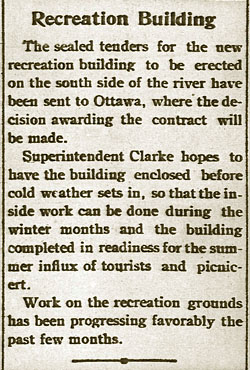 |
|
|
|
1:
October 11, 1913.
"Recreation Building. The sealed tenders for the new
recreation building to be erected on the south side of the
river have been sent to Ottawa, where the decision awarding
the contract will be made. Superintendent Clarke hopes to
have the building enclosed before cold weather sets in...
Work on the recreation grounds has been progressing..."
(Photocopy courtesy of the Whyte Museum of the Canadian
Rockies, Banff, Alberta.) |
|
|
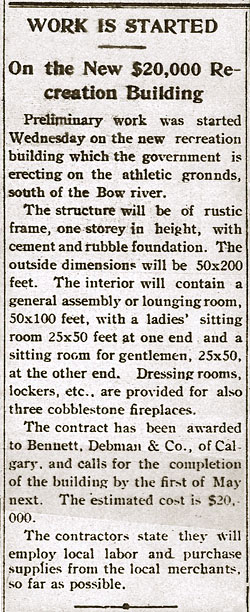 |
|
2: Excitement builds.
October 18, 1913. Bids have been awarded. Jobs are
opening up. One week later it is reported that: "Work is
Started - On the New $20,000 Recreation Building.
Preliminary work was started... The structure will be of
rustic frame, one storey in height, with cement and rubble
foundation. The outside dimension will be 50x200 feet... The
contract has been awarded to Bennett, Debman & Co., of
Calgary, and calls for the completion of the building by the
first of May..." (Photocopy courtesy of the Whyte Museum of
the Canadian Rockies, Banff, Alberta.) |
|
|
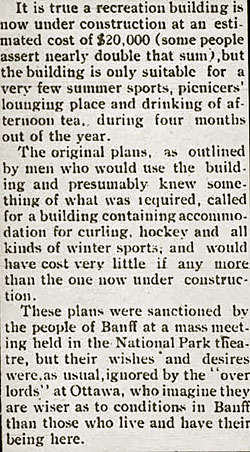 |
|
3: Enthusiasm wanes as
resentment sets in. December 6, 1913. "It is true
a recreation building is now under construction... but the
building is only suitable for a very few summer sports,
picnicers’ lounging place and drinking of afternoon tea,
during four months of the year... The original plans, as
outlined by men who would use the building as outlined by
men who would use the building and presumably know something
of what was required, called for a building containing
accommodations for curling, hockey and all kinds of winter
sports, and would have cost very little if any more than the
one now under construction. These plans were sanctioned by
the people of Banff at a mass meeting held in the National
Park theater, but their wishes and desires were, as usual,
ignored by the 'over lords' at Ottawa, who imagine they are
wiser as to conditions in Banff than those who live and have
their being here." Ottawa held the purse strings. (Photocopy
courtesy of the Whyte Museum of the Canadian Rockies, Banff,
Alberta.) |
|
|
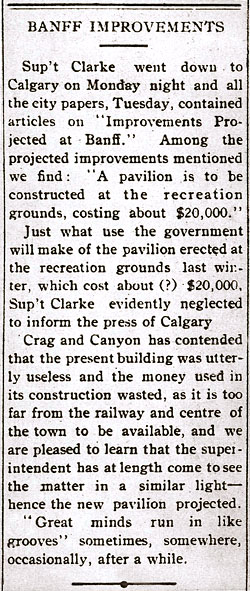 |
|
4: June 13, 1914.
"Banff Improvements. Sup’t Clarke went down to Calgary on
Monday night and all the city papers, Tuesday, contained
articles on ‘Improvements Projected at Banff’... Just what
use the government will make of the pavilion erected at the
recreation grounds last winter... neglected to inform the
press of Calgary... Crag and Canyon has contended that the
present building was utterly useless and the money used in
construction wasted..." (Photocopy courtesy of the Whyte
Museum of the Canadian Rockies, Banff, Alberta.) |
|




